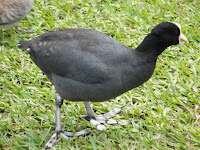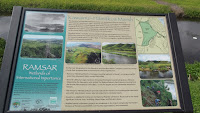CONSERVATION IN HAWAII
BIRD HABITAT CONSERVATION IN HAWAII
(for general conservation issues please see THIS PAGE)
CLIMATE: The Hawaiian Islands, thanks to their location in the middle of the Pacific Ocean above the Equator, have a balmy climate around the year. However for the large, mountainous islands, this climate is impacted by the high land mass of those mountains. This means that the predominant trade winds from the north east bring moisture to the east side of those islands, but the mountains block that moisture from reaching the west side.
DRY SCRUBLAND vs RAIN FOREST: See the map below that illustrates this phenomenon, which has a tremendous impact on the type of vegetation growing on those islands. On the west side, the more red the color the less rain is falling. As a result, mostly scrubland is found on that side. On the east side, copious amounts of rain create rain forests, marshes, water falls, etc.
BIRD HABITATS: These differences have an obvious influence on the bird habitats. Species that thrive on dry scrubland would not survive in the rain forest, and vice versa. This is well illustrated on the Oahu satellite map below, with the Ko’olau Mountain range greener, and the west side more brown.
HABITAT CONSERVATION
Many initiatives have been undertaken over the years in Hawaii, and are still ongoing, for preserving bird habitat. Here are a few examples:
NATIONAL WILDLIFE REFUGES (for the large islands):
Hakalau Forest NWR (Mauna Kea east slope, Big Island)
Hanalei NWR (part of the Kauai National Refuge Complex)
Hulē’ia NWR (Kauai)
James Campbell NWR (Oahu, north east point)
Kakahaia NWR (Molokai)
Kealia Pond NWR (Maui, near Kihei)
Kilauea Point NWR (Kauai, north east point)
Oahu Forest NWR (Oahu, northern Ko’olau Mountains)
Pearl Harbor NWR (Oahu)
ISLETS STATE BIRD SANCTUARIES
– The eastern shore of Oahu has many islets that are now state bird sanctuaries, and as such are protected. These small rocky islands are nesting grounds for many species of seabirds, such as boobies, tropicbirds, shearwaters, etc.
KAENA POINT COASTAL RESERVE (Part of the Natural Areas Reserve System) – This point on Oahu now has a thriving colony of Laysan Albatross, in addition to Wedge-tailed shearwaters.
The Kawainui-Hamakua Marsh Complex: at over 800 acres on the Oahu east shore, this wetland is the largest in Hawaii. It is an ideal habitat for water birds such as the endangered Hawaiian Stilt (Ae’o), Hawaiian Coot (Alae Ke’oke’o) and Hawaiian Gallinule (Alae’ula).
This marsh is also part of the international RAMSAR accredited wetlands for the protection and conservation of wildlife, especially birds.
WHITE TERN NESTING SITES PROTECTION
White terns in Honolulu are not building real nests. Instead they very often use tree branch elbows to lay their one egg. There is a program in place to warn city tree trimmers of bird nesting sites when doing their tree maintenance work:
HAWAIIAN HONEYCREEPERS
The Hawaiian honeycreeper is a small passerine bird endemic to Hawaii. It has evolved through adaptive radiation into various bill shapes, adapted to specific flower species. Many of the species have become extinct in the recent past, and many others are critically endangered. They are mostly confined to high mountain elevations and are very difficult to observe due to their rarity. Seeing - and photographing - one is almost like finding the 'Holy Grail' of birding!
Many bird conservation initiatives on Hawaii are aimed at protecting the Hawaiian honeycreepers. One recent threat is the Ohi'a Rapid Death, which kills the Ohi'a trees. These trees are an important food source for the honeycreepers.
(for general conservation issues please see THIS PAGE)
CLIMATE: The Hawaiian Islands, thanks to their location in the middle of the Pacific Ocean above the Equator, have a balmy climate around the year. However for the large, mountainous islands, this climate is impacted by the high land mass of those mountains. This means that the predominant trade winds from the north east bring moisture to the east side of those islands, but the mountains block that moisture from reaching the west side.
DRY SCRUBLAND vs RAIN FOREST: See the map below that illustrates this phenomenon, which has a tremendous impact on the type of vegetation growing on those islands. On the west side, the more red the color the less rain is falling. As a result, mostly scrubland is found on that side. On the east side, copious amounts of rain create rain forests, marshes, water falls, etc.
BIRD HABITATS: These differences have an obvious influence on the bird habitats. Species that thrive on dry scrubland would not survive in the rain forest, and vice versa. This is well illustrated on the Oahu satellite map below, with the Ko’olau Mountain range greener, and the west side more brown.
 |
| The Hawaiian Islands (public domain) |
 |
| Hawaii Annual Precipitation University of Hawaii |
Many initiatives have been undertaken over the years in Hawaii, and are still ongoing, for preserving bird habitat. Here are a few examples:
NATIONAL WILDLIFE REFUGES (for the large islands):
Hakalau Forest NWR (Mauna Kea east slope, Big Island)
Hanalei NWR (part of the Kauai National Refuge Complex)
Hulē’ia NWR (Kauai)
James Campbell NWR (Oahu, north east point)
Kakahaia NWR (Molokai)
Kealia Pond NWR (Maui, near Kihei)
Kilauea Point NWR (Kauai, north east point)
Oahu Forest NWR (Oahu, northern Ko’olau Mountains)
Pearl Harbor NWR (Oahu)
 |
| James Campbell National Wildlife Refuge, Oahu |
– The eastern shore of Oahu has many islets that are now state bird sanctuaries, and as such are protected. These small rocky islands are nesting grounds for many species of seabirds, such as boobies, tropicbirds, shearwaters, etc.
KAENA POINT COASTAL RESERVE (Part of the Natural Areas Reserve System) – This point on Oahu now has a thriving colony of Laysan Albatross, in addition to Wedge-tailed shearwaters.
 |
| Kaena Point Coastal Reserve, Oahu |
 |
| Double gate and fence, west side entry |
The Kawainui-Hamakua Marsh Complex: at over 800 acres on the Oahu east shore, this wetland is the largest in Hawaii. It is an ideal habitat for water birds such as the endangered Hawaiian Stilt (Ae’o), Hawaiian Coot (Alae Ke’oke’o) and Hawaiian Gallinule (Alae’ula).
This marsh is also part of the international RAMSAR accredited wetlands for the protection and conservation of wildlife, especially birds.
 |
| Hawaiian Stilt, Hamakua Marsh, Oahu |
 |
| Hawaiian Gallinule, Hamakua Marsh |
 |
| Hawaiian Coot, Ho'omaluhia Botanical Garden |
 |
| Hamakua Marsh, Kailua, Oahu |
 |
| Formation history of Hamakua Marsh |
 |
| Hamakua Marsh is a RAMSAR wetland |
WHITE TERN NESTING SITES PROTECTION
White terns in Honolulu are not building real nests. Instead they very often use tree branch elbows to lay their one egg. There is a program in place to warn city tree trimmers of bird nesting sites when doing their tree maintenance work:
 |
| Warning! White tern nesting site! |
HAWAIIAN HONEYCREEPERS
The Hawaiian honeycreeper is a small passerine bird endemic to Hawaii. It has evolved through adaptive radiation into various bill shapes, adapted to specific flower species. Many of the species have become extinct in the recent past, and many others are critically endangered. They are mostly confined to high mountain elevations and are very difficult to observe due to their rarity. Seeing - and photographing - one is almost like finding the 'Holy Grail' of birding!
Many bird conservation initiatives on Hawaii are aimed at protecting the Hawaiian honeycreepers. One recent threat is the Ohi'a Rapid Death, which kills the Ohi'a trees. These trees are an important food source for the honeycreepers.
 |
| Hawaiian honeycreepers are critically endangered |